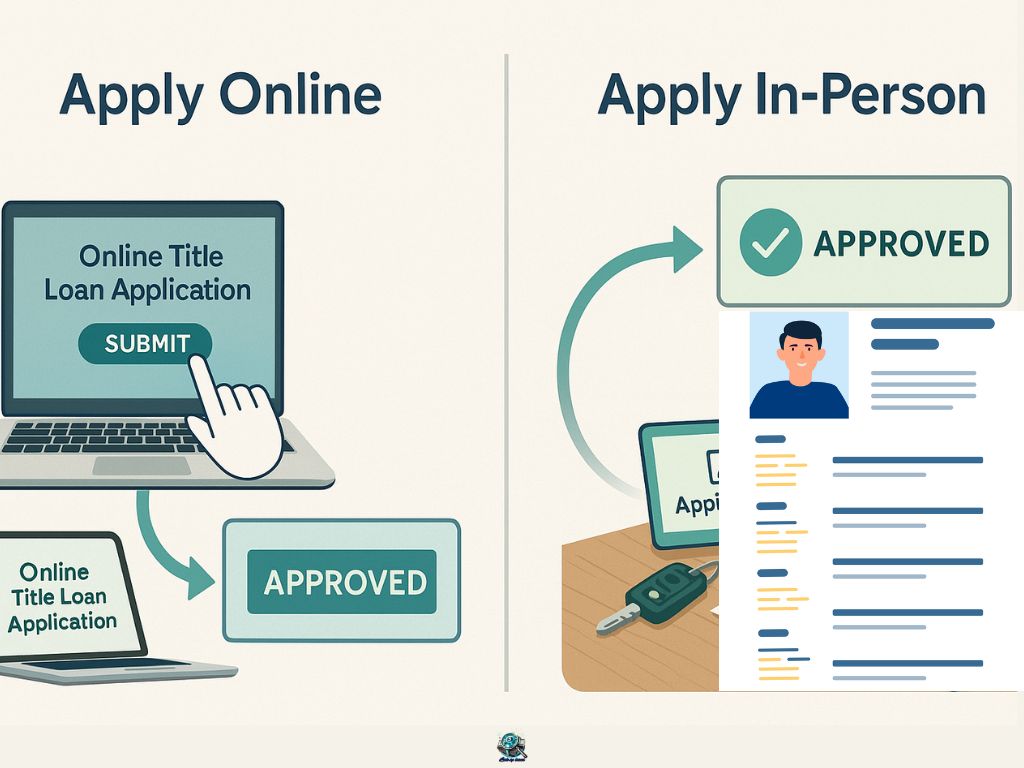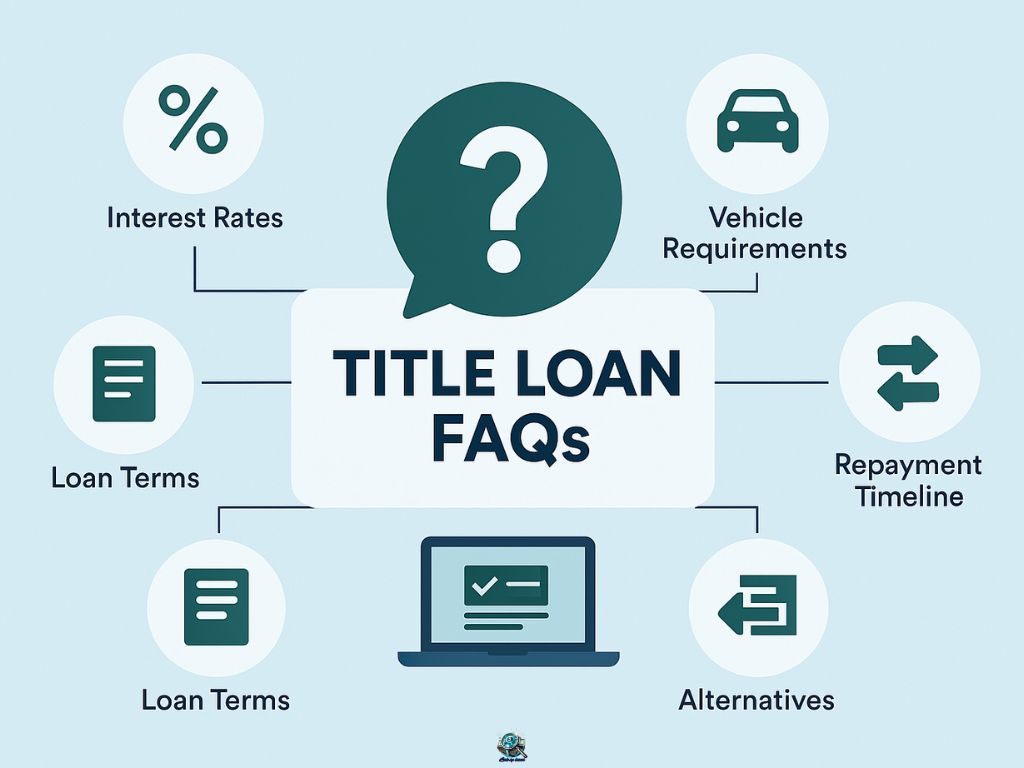Introduction: Understanding the Real Cost of Fast Cash
When money runs short and expenses pile up, finding quick cash can feel like a race against time. That’s when title loans start to look appealing fast approval, no credit check, and cash in hand within hours.
But while title loans seem simple on the surface, they often come with hidden costs and serious risks. Without fully understanding how these loans work, many borrowers end up trapped in a cycle of debt and sometimes lose their vehicle altogether.
Before you borrow against your car, it’s essential to know exactly what you’re signing up for.
This guide breaks down everything you need to understand so you can make a smarter, safer financial decision.
Key Takeaways
- Understand exactly how title loans work and what lenders don’t always tell you.
- Learn how much you can realistically borrow and what it will cost in the long run.
- Find out what happens if you miss a payment and how to avoid repossession.
- Discover safer, smarter alternatives before risking your vehicle.
- Get a step-by-step overview of how to apply safely if you decide to move forward.
Disclaimer: This site contains affiliate links. If you make a purchase, we may earn a commission at no extra cost to you.

Understanding Title Loans: What Is a Title Loan and How Does It Work?
At their core, title loans are short-term, high-interest loans that allow you to borrow money using your vehicle as collateral. Instead of evaluating your credit score, the lender holds your car’s title as a guarantee that the loan will be repaid.
Here’s how it works:
You agree to hand over the title of your fully owned vehicle usually a car, truck, or motorcycle in exchange for a loan, often ranging from a few hundred to several thousand dollars. In most cases, you’ll still be able to drive your vehicle while the loan is active, but if you fail to repay as agreed, the lender has the right to repossess it.
Title loans are popular for their speed and simplicity. Applications are usually fast, approvals happen quickly, and funds are often available within a single day. That makes them tempting for people facing urgent financial needs.
But convenience comes at a cost. Title loans typically carry much higher interest rates than traditional loans, and the repayment period is often very short sometimes as little as 30 days.
Understanding exactly how a title loan operates and what you’re risking is the first step toward making a smart financial decision.
➔ To learn more about safer collateral loans, read our guide on secured personal loans.

📊 The Title Loan Process Step by Step (and What to Watch Out For)
| Step | What Happens | What to Watch Out For |
|---|---|---|
| 1. Apply Online or In-Person | You fill out a short application with basic personal and vehicle info. | Some lenders collect minimal info to approve fast; be cautious of vague forms. |
| 2. Vehicle Evaluation | Lender assesses your car’s value using data or a visual inspection. | Inflated estimates may lead to unrealistic loan offers, stay grounded. |
| 3. Loan Offer & Agreement | You receive a loan offer (typically 25–50% of car value) with terms. | Look for small-print fees and short repayment timelines (15–30 days). |
| 4. Hand Over the Title | You give the lender your car title; they become lienholder. | You still drive the car but legally, they now control ownership. |
| 5. Receive Your Funds | Money is disbursed by cash, check, or direct deposit. | “Fast cash” often hides expensive repayment conditions, review the APR. |
| 6. Repay or Roll Over | You must repay in full by the due date or roll over with new fees. | Most borrowers end up rolling over leading to a cycle of rising debt. |

How the Title Loan Process Works
Getting a title loan usually follows a simple, fast-moving process but the speed can sometimes hide the risks.
Here’s what typically happens:
1. Apply Online or In-Person
Borrowers start by completing a short application, either online or at a lender’s physical location. Basic personal information, details about the vehicle, and proof of ownership are required.
2. Vehicle Evaluation
The lender assesses the value of the vehicle. This is based on make, model, year, mileage, and condition. Some lenders perform a quick visual inspection, while others rely on data from trusted vehicle valuation databases.
3. Loan Offer and Agreement
Once the vehicle’s value is determined, the lender offers a loan amount often 25% to 50% of the car’s market value. You’ll be asked to sign a loan agreement outlining the terms, interest rate, fees, and repayment schedule.
4. Hand Over the Title
After signing, you’ll hand over the physical title to your car. The lender becomes a lienholder on your vehicle during the loan term. In most cases, you can still drive your car while repaying the loan.
5. Receive Your Funds
Once everything is finalized, you’ll receive your loan sometimes in cash, other times via direct deposit. The entire process can often be completed in less than a day.
6. Repay or Renew
The loan usually must be repaid in full within 15 to 30 days. Some borrowers who can’t repay on time renew or roll over their loan often leading to additional fees and mounting debt.

Are Title Loans Legal in the U.S.?
Title loans are legal in many parts of the United States, but the rules vary significantly depending on where you live.
Some states allow title loans with few restrictions, while others impose strict regulations on loan amounts, interest rates, and repayment terms. A handful of states ban title loans altogether or have laws that make it extremely difficult for lenders to operate.
Where they are legal, lenders typically must follow specific licensing requirements, disclose all terms clearly, and limit the annual percentage rate (APR) they can charge. However, even in regulated states, title loans can still carry extremely high costs compared to traditional forms of credit.
Because of these major differences, it’s essential to check the laws in your state before applying. Some lenders operate online across state lines, which can further complicate the legal protections available to you.
Understanding the legal framework where you live can protect you from unexpected fees, unfair practices, and the risk of losing your vehicle too easily.
🏛️ State Laws Snapshot: Where Title Loans Are Legal (and Risky)
Here is a fact-checked and updated version of the table based on the most current available information. Please note that state laws can change, and it’s always best to verify with the state’s Department of Financial Services or Attorney General’s office.
| State | Legal Status | Max APR / Cap | Notes |
|---|---|---|---|
| California | Legal | No APR cap (over $2,500) | Loans under $2,500 are capped, but larger title loans have no interest rate limits. |
| Texas | Legal (regulated) | No meaningful cap | Lenders operate as “Credit Access Businesses” (CABs), allowing very high fees. |
| Florida | Legal (regulated) | Tiered rates (~30–48%) | Licensed lenders; max loan term is 30 days. |
| Illinois | Effectively Banned | 36% APR cap | Predatory Loan Prevention Act of 2021 made high-cost title loans unsustainable. |
| New York | Banned | 16%–25% APR cap | Strict usury laws prevent title loan operations. |
| Arizona | Effectively Banned | 36% APR cap | Fair Lending Act (2020) capped rates, eliminating high-cost title loans. |
| Missouri | Legal | 300%+ APR allowed | One of the most permissive states, with no cap on rates. |
| Nevada | Legal | No APR cap | High-interest loans allowed; lenders must consider repayment ability. |
| Georgia | Legal (regulated) | ~187.5% APR max | Regulated under pawn laws; capped monthly, but still very high annual APR. |
| North Carolina | Banned | N/A | Strict laws + prosecutions effectively ban title loans. |
Important Note: The information above is a general overview. Online lenders may attempt to operate across state lines, but your local state laws still apply. Always check with your state’s official financial regulatory body before engaging in any loan agreement.

How Much You Can Borrow and What You Need to Qualify
One of the main appeals of a title loan is the ability to borrow cash quickly based on the value of your vehicle, not your credit history. But how much you can borrow and whether you qualify at all depends on a few important factors.
Understanding these requirements upfront can help you avoid surprises during the application process.
How Loan Amounts Are Determined
The amount you can borrow with a title loan is directly tied to the value of your vehicle. Lenders typically offer between 25% to 50% of the car’s current market value.
When determining the loan amount, lenders consider:
- Make, model, and year of the vehicle
- Mileage (lower mileage usually means higher value)
- Condition (both mechanical and cosmetic)
- Current market demand for that type of vehicle
Some lenders use national pricing guides like Kelley Blue Book, while others perform their own appraisal. If your car is older, has high mileage, or has significant wear and tear, the loan amount offered could be much lower than you expect.
Basic Eligibility Requirements
While title loans are known for being easy to qualify for, there are still a few basic requirements you must meet:
- You must own your vehicle outright. (No outstanding loans or liens the title must be clean.)
- You must provide a valid government-issued ID.
- You must show proof of residence. (Utility bills or lease agreements usually work.)
- You must have proof of insurance. (Some lenders require this, especially for larger loans.)
If you meet these basic conditions, you’re likely eligible to apply regardless of your credit history.
Required Documentation Checklist
Before you apply, it’s smart to gather the documents most lenders will ask for. Having these ready can speed up the approval process.
Here’s what you’ll typically need:
- Vehicle title (in your name, with no liens)
- Valid driver’s license or state ID
- Proof of residence (utility bill, lease, or mortgage statement)
- Proof of income (pay stubs, bank statements, benefits letters)
- Vehicle registration and insurance documents
- Spare key (sometimes requested by the lender)
Not every lender asks for every document, but being prepared can save you from delays or rejections.

Can You Get a Title Loan with Bad Credit?
Yes. One of the biggest reasons people turn to title loans is that your credit score usually doesn’t matter.
Because the loan is secured by your vehicle, lenders focus more on the value of your car and your ability to repay than on your past credit history. This makes title loans accessible even for people with poor credit or past financial difficulties.
However, it’s important to remember: Bad credit often means you’ll face higher interest rates and stricter terms. And if you default, you still risk losing your car regardless of your credit score.

Income and Employment Considerations
One of the reasons title loans are popular is that they don’t always require a traditional full-time job for approval. While steady income is important, lenders today accept a wide range of income sources as long as you can show you have a reliable way to repay the loan.
Understanding what qualifies as income can make the process smoother and increase your chances of getting approved.
Do You Need a Traditional Job to Apply?
No, you do not need a regular 9-to-5 job to qualify for a title loan.
Lenders are mainly interested in your ability to repay the loan, not necessarily where your money comes from. As long as you can prove consistent income, you may still be eligible.
Common alternative income sources that lenders often accept include:
- Retirement income (pensions, Social Security benefits)
- Self-employment income (freelancers, contractors, small business owners)
- Disability benefits (government or private)
- Unemployment benefits (in some cases, depending on stability)
- Worker’s compensation payments
- Structured settlements (long-term payout agreements)
Each lender has slightly different standards, so it’s a good idea to check in advance if your specific income source qualifies.
How Alternative Incomes Can Help You Qualify
If you’re relying on non-traditional income, it’s important to show stability and consistency. Lenders are more likely to approve your loan if you can provide:
- Recent bank statements showing regular deposits
- Award letters or official documents confirming benefits
- Tax returns if you’re self-employed
- Invoices or payment records from steady freelance work
The more documentation you can provide, the stronger your application will be and the better your chances of securing a fair loan offer.
Even though title loans don’t involve deep credit checks, lenders still want some assurance that you’ll be able to repay on time.
Proving income clearly is key to getting approved without unnecessary delays or lower loan offers.

Defaulting on a Title Loan: What Happens and How to Protect Yourself
Title loans can feel like a fast solution when money is tight, but defaulting on one can create serious consequences far beyond just losing your car.
Understanding the risks before you sign any agreement is essential. It could mean the difference between temporary relief and long-term financial trouble.
What Happens If You Default?
If you miss a payment or can’t repay your title loan according to the agreed terms, the lender has the legal right to repossess your vehicle.
Here’s how the process usually unfolds:
- Late Payment Notices
Most lenders will send you a notice informing you that you’re past due. Some may allow a brief grace period, but many start repossession actions quickly. - Repossession of Your Vehicle
If you still haven’t paid, the lender can send a tow company to repossess your vehicle often without warning. In many states, they don’t even need a court order. - Vehicle Sale
After repossessing the car, the lender typically sells it at auction. They use the proceeds to pay off your loan balance and any additional repossession and storage fees. - You May Still Owe Money
If the car sells for less than what you owe (loan balance + fees), some states allow the lender to pursue you for the remaining balance called a deficiency balance.
Defaulting doesn’t just cost you your car. It can damage your finances even further if you still owe money after repossession.
➔ For more information, see the Consumer Financial Protection Bureau guidelines.

How to Avoid Default and Protect Your Car
While title loans are risky, there are smart steps you can take to protect yourself:
- Borrow Only What You Absolutely Need
Don’t accept the maximum loan offer just because it’s available. Borrow the smallest amount necessary to solve your immediate problem. - Have a Realistic Repayment Plan
Before you sign anything, know exactly how and when you’ll repay the loan. If it doesn’t fit your budget, reconsider. - Communicate Early if You Hit Trouble
If you think you’ll miss a payment, contact your lender immediately. Some lenders offer extensions or renegotiation options if you’re proactive. - Understand the Total Cost
Know your full repayment amount, including all interest and fees. If the numbers don’t add up comfortably, don’t move forward.
Title loans are structured to benefit lenders, not borrowers. The more carefully you plan, the better your chances of avoiding the serious consequences that come with default.

How to Apply for a Title Loan (Online vs. In-Person)
Applying for a title loan is designed to be quick and simple but how you apply can affect your experience, the speed of your approval, and even your loan terms.
Today, most lenders offer both online and in-person application options. Understanding the differences can help you choose the path that fits your needs best.
Online Applications: Speed and Convenience
Online title loans have become increasingly popular, especially for borrowers who need cash fast and want to avoid a trip to a store.
Advantages of applying online:
- Speed: Many online applications can be completed in under 10 minutes.
- Convenience: Upload your documents electronically without visiting a location.
- Pre-approval offers: Some lenders provide instant estimates based on the information you submit.
Potential risks of applying online:
- Higher risk of predatory lenders: Not all online lenders are legitimate some charge excessive hidden fees or operate without proper licenses.
- Less personal service: If you have questions or special circumstances, getting support can be harder online.
If you choose the online route, make sure the lender is licensed and check reviews carefully before submitting personal information.
In-Store Applications: Personal Interaction and Vehicle Inspection
Traditional in-person title loan applications are still common, especially for larger loan amounts or first-time borrowers.
Advantages of applying in-person:
- Immediate vehicle inspection: Lenders can assess your car on the spot, possibly leading to a better loan offer.
- Face-to-face support: You can ask questions, review terms, and negotiate more easily.
- Immediate document verification: Speeds up the approval process without worrying about scanning or uploading.
Potential drawbacks of applying in-person:
- Takes more time: You’ll need to travel to a location and possibly wait in line.
- Pressure to accept terms: Some lenders use in-person meetings to push borrowers into quick decisions.
Whether you apply online or in person, remember: speed is not a substitute for caution.
Always review your loan terms carefully before signing anything.
The Typical Title Loan Application Process
No matter where you apply, the basic steps are usually the same:
1. Submit Your Application
Provide basic personal information, details about your vehicle, and upload or present required documents.
2. Get Approved and Receive an Offer
The lender reviews your application, verifies your documents, assesses your vehicle’s value, and makes a loan offer.
3. Sign the Agreement and Hand Over Your Title
After reviewing the loan terms carefully, you’ll sign the agreement and provide your vehicle’s title to the lender.
4. Receive Your Cash
Once the paperwork is complete, the lender disburses your loan often within the same day.
📊 Online vs. In-Person Title Loan Applications: What to Expect
| Factor | Online Application | In-Person Application |
|---|---|---|
| Speed | Often under 10 minutes, fully digital | Varies; may require waiting, physical paperwork |
| Vehicle Evaluation | Photos or database lookup | On-site inspection by lender |
| Document Submission | Upload scans or photos from your device | Present hard copies to staff |
| Support & Questions | Limited; usually email or chatbot | Face-to-face Q&A with staff |
| Loan Offer Timing | Sometimes instant, based on input data | Typically same-day after inspection |
| Approval Confidence | Fast, but less personalized | Slower, but may allow negotiation |
| Risk of Pressure Tactics | Lower; more control over pace | Higher; some reps may push for fast decisions |
| Best For | Tech-savvy borrowers who want speed and convenience | First-timers or those with special circumstances |

How to Maximize the Value of Your Vehicle Before Borrowing
Because your loan amount depends heavily on the value of your vehicle, taking a few extra steps before applying can put more cash in your pocket or at least give you stronger negotiating power.
Most lenders will quickly inspect your car’s condition and look up its market value. Even small improvements can make a difference in the offer you receive.
Here’s how to get the best valuation possible.
Tips to Boost Your Vehicle’s Appraisal
1. Clean Your Car Thoroughly
A well-presented car signals better care and maintenance history. Wash and wax the exterior, vacuum the interior, and wipe down all surfaces. A clean, polished vehicle can easily look hundreds of dollars more valuable than a dirty one.
2. Fix Minor Cosmetic Issues
Small dents, scratches, or broken lights can lower your car’s value fast. If the fixes are inexpensive, like replacing a headlight bulb or touching up a scratch, it’s often worth doing before an inspection.
3. Take Care of Basic Maintenance
Top off fluids, check tire pressure, and replace worn-out windshield wipers. Even simple actions show the vehicle is road-ready, which can reassure lenders.
4. Gather Maintenance Records
If you’ve kept up with oil changes, brake replacements, or other service milestones, show those records. A well-maintained car often appraises higher and makes you look more responsible as a borrower.
5. Remove Personal Items
Clearing out clutter from your trunk, backseat, and glove compartment gives a cleaner, more professional impression.
Understand How Vehicle Equity Impacts Your Loan Offer
Remember: lenders rarely offer you the full value of your car.
Most title loan companies only offer 25% to 50% of your vehicle’s appraised value and they tend to be conservative. If your car is valued at $10,000, you might only be offered $2,500 to $5,000.
Improving your vehicle’s presentation won’t change the formula lenders use, but it can push your appraisal toward the higher end of their range which means a better offer with potentially more favorable terms.
Every dollar counts when you’re borrowing under high-interest conditions.
Maximizing your vehicle’s value before you walk through the lender’s door is one of the smartest moves you can make.

📊 What to Consider Before Taking a Title Loan
Before signing any contract, ask yourself these key questions. A “No” answer is a red flag:
| Question to Ask Yourself | Why It Matters | If Your Answer Is “No”… |
|---|---|---|
| Can I repay the full amount on time? | Title loans are due in 15–30 days. Late = more fees or repossession. | You’re risking your car. |
| Do I know the total cost of the loan? | The APR, fees, and repayment terms must be 100% clear. | You could end up owing double. |
| Have I compared at least 2–3 lenders? | Offers, rates, and fees can vary wildly between companies. | You’re likely overpaying. |
| Is this loan solving the problem or delaying it? | Some loans fix cash flow, others just shift the pain forward. | Consider alternatives first. |
| Have I explored safer options (credit union, PAL, assistance)? | There may be lower-risk ways to solve the same issue. | You might be making a costly move. |
| Do I fully own my car and understand what happens if I default? | If you miss payments, the lender may legally seize and sell your car. | Read the fine print twice. |
Considerations Before Taking a Title Loan
Title loans offer fast cash when you need it most but they also come with significant risks.
Before you sign anything, it’s important to step back and ask yourself whether this is truly the best option for your situation.
Here’s what to consider before moving forward.
Is a Title Loan Really the Best Option?
A title loan might seem like a quick fix, but in many cases, it’s not the smartest financial move.
Because of the extremely high interest rates, short repayment windows, and risk of losing your car, title loans are often considered a last resort not a first choice.
You might consider a title loan only if:
- You have no other borrowing options available.
- You are absolutely certain you can repay the loan in full and on time.
- You fully understand the total cost of the loan, including fees and interest.
If any of these conditions aren’t met, it’s wise to pause and consider safer alternatives before risking your vehicle.
Smart Steps to Take Before Signing Anything
If you’re still considering a title loan after weighing the risks, make sure you take these steps first:
- Compare Multiple Lenders
Don’t accept the first offer you receive. Different lenders have different fees, interest rates, and repayment terms. - Read Every Term Carefully
Look beyond the monthly payment. Understand the full repayment amount, all fees, and the consequences of missing a payment. - Calculate the True Cost
Title loans can look affordable at first glance, but once you add up the fees and interest over a few weeks, they often cost far more than expected. - Create a Repayment Plan Before You Borrow
Know exactly how you’ll pay back the loan before you accept it. If you don’t have a clear plan, reconsider. - Talk to Someone You Trust
Sometimes just discussing the situation with a friend, family member, or financial advisor can help you see options you might have missed.
Taking a few extra steps now could save you from losing your vehicle and a lot of money later. Borrowing against your car’s title is a serious decision.
Make sure you go into it with your eyes open and a plan in place.
📊 Title Loans vs Safer Alternatives
Title loans may seem fast, but their hidden costs are brutal. Here’s how they compare with safer, lower-risk options:
| Option | Collateral Required | Typical APR | Funding Speed | Risk Level | Best For… |
|---|---|---|---|---|---|
| Title Loan | Yes (Car Title) | 100% – 300%+ | Same day (often) | Very High | Fast cash with no credit check |
| Credit Union Personal Loan | No | 6% – 28% | 1–3 days | Low | People with fair or limited credit |
| Payday Alternative Loan (PAL) | No | Capped at 28% (FCUs) | 1–2 business days | Low | Safer emergency loan from a credit union |
| Emergency Assistance Program | No | None | Varies | Very Low | Rent, utility, or crisis support |
| Borrowing from Family/Friends | No | 0% (if agreed) | Immediate | Medium | Short-term help without interest |
| Cash Advance Apps | No | $0 – $10 flat fee | Same day | Medium | Instant access to $100–$500 |
Smarter Alternatives to Title Loans
If you’re facing a financial emergency, it can feel like a title loan is your only option.
But the good news is: safer, more affordable alternatives do exist and many of them come with lower costs and fewer risks.
Before risking your vehicle and your financial future, consider exploring these options first.
➔ If you’re exploring safer options, check out personal loans for bad credit to see how you can borrow without risking your car.
Personal Loans from Credit Unions or Community Banks
Credit unions and local banks often offer small personal loans at much lower interest rates than title lenders.
Even if your credit isn’t perfect, they may work with you if you have steady income and a reasonable ability to repay.
Many credit unions also offer Payday Alternative Loans (PALs) small-dollar loans designed specifically to provide safer options for emergency borrowing.
Borrowing from Family or Friends
If you have trusted relationships, borrowing from family or friends can be a far cheaper and safer alternative.
It’s important to set clear terms in writing to avoid misunderstandings, but this route can help you avoid predatory interest rates and the risk of losing your car.

Negotiating Payment Plans with Creditors
If a specific bill or obligation triggered your cash need, consider calling your creditor directly.
Many utility companies, medical providers, and landlords offer payment plans or short-term relief programs especially if you explain your situation upfront.
Using a Credit Card (With Caution)
While credit cards carry their own risks, using a card with a low-interest promotional rate might be a better short-term solution than a high-APR title loan.
Just be cautious: avoid running up new debt unless you have a clear repayment plan.
Emergency Assistance Programs
Depending on your situation, you may qualify for temporary help from local nonprofits, churches, or government programs.
These can provide assistance with rent, utilities, medical bills, or even small cash grants no collateral required.
Taking a little more time to explore safer options could protect your car, your wallet, and your peace of mind.
A fast loan isn’t worth it if it costs you your freedom or financial security.
Disclosures and Further Resources
Before applying for any type of loan especially a high-cost title loan, it’s critical to fully understand the terms, fees, and total repayment obligations.
Always review the loan agreement carefully and make sure you’re dealing with a licensed, reputable lender.
This guide is provided for informational purposes only and does not constitute financial advice. Individual loan terms and legal protections vary depending on your location and personal financial situation.
If you need personalized advice, consider speaking with a certified financial counselor or legal professional.

Final Thoughts: Think Carefully Before You Borrow
Title loans can offer fast relief when you’re facing a financial emergency but they come at a steep price. Before you risk your vehicle and your peace of mind, make sure you’ve explored every alternative.
If you do decide to move forward with a title loan, do it with full awareness: know exactly what you’re signing, how much it will truly cost, and how you’ll repay it without falling into a debt trap.
Fast money feels good in the moment. But smart money decisions feel good for a lifetime.
Take your time. Ask questions. Protect yourself. The right choice today could save you from years of financial stress tomorrow.

Frequently Asked Questions (FAQ)
Q: Can I get a title loan if my car isn’t fully paid off?
A: Usually no. Most lenders require a “clear” title with no outstanding liens. Some may offer refinancing options, but these are rare and often come with extra risks.
Q: How fast can I get cash from a title loan?
A: Many title loans can be completed in one business day. Some online lenders even offer same-day funding, depending on how quickly you submit your documents.
Q: Will a title loan affect my credit score?
A: Generally, title loans don’t require a credit check for approval, and many lenders don’t report payments to credit bureaus. However, if your vehicle is repossessed and the lender pursues collections, it could eventually impact your credit.
Q: What happens if I can’t repay my title loan on time?
A: If you can’t repay by the due date, the lender may allow you to “roll over” the loan but this usually comes with extra fees and higher debt. If you still can’t pay, the lender can repossess and sell your vehicle.
Q: Are online title loans safe?
A: Some online lenders are legitimate and licensed, but many are not. Always verify that a lender is properly licensed in your state and read all terms carefully before applying.
Q: Can I refinance a title loan to avoid repossession?
A: In some cases, yes. Some lenders allow borrowers to refinance a title loan by replacing it with a new loan, possibly with different terms. However, this often just extends the debt and adds more fees, not always reducing the risk. Refinancing should only be considered if it meaningfully lowers your payment or helps you avoid repossession and you have a clear plan to pay it off.
Q: What happens to my car insurance during a title loan?
A: Most lenders require you to maintain active car insurance while the loan is in place. Some may even ask to be listed as a lienholder on your insurance policy. If your coverage lapses, it can trigger default increasing the risk of repossession or extra fees. Always check the lender’s insurance requirements before signing.
Q: Do I lose equity in my vehicle when I take out a title loan?
A: Technically, no but practically, yes. While the loan doesn’t change your ownership or reduce the car’s value, any equity you’ve built is at risk. If you default and the car is repossessed or sold below market value, you lose access to that equity. That’s why using a high-equity car for a small loan can be risky.
2 Comments
Emergency Car Title Loans: Fast Cash or a Dangerous Trap? - Look Up Loans · April 18, 2025 at 3:40 pm
[…] you’re not sure what a title loan really is, start here before diving into emergency […]
Personal Loans: Read This Before You Sign Anything - Look Up Loans · October 9, 2025 at 1:08 pm
[…] Title loans let you borrow against your car and lose it in a single missed payment. These are not emergency options. They are debt accelerators, not debt solutions. […]